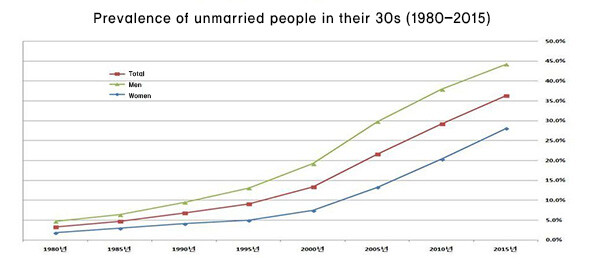hankyoreh
Links to other country sites 다른 나라 사이트 링크
Across all age groups, South Korean singles are older on average

South Korean singles are older on average than five years ago in all age groups. The increase in the singles population was especially steep at what is considered “optimal” marrying age (late twenties to early thirties), as well as the period from the late thirties to early forties.
According to estimates based on a 2015 population and housing sample announced by the Ministry of Strategy and Finance on Dec. 19, South Korea‘s unmarried population rose from 12,312,000 in 2010 to 13,376,000 in 2015, an increase of 1,064,000 people (0.7%). Percentages of unmarried people rose across all age groups.
The increase was highest for unmarried people in their thirties, rising 7.1 percentage points from 29.2% in 2010 to 36.3% in 2015. Among fortysomethings, the rate was up 5.7 percentage points from 2010 to 13.6%; males showed a 7.3 percentage point rise (from 10.9% in 2010 to 18.2% in 2015), outstripping the 6.3 percentage point increase for those in their thirties.
A closer look at age groups showed a notably sharp increase in the never-married population in their late thirties to early forties. The rate of increase for those aged 30-34 was highest at 7.2 percentage points from five years before (46.9% of the unmarried population), but rates were similarly high for the 35-39 and 40-44 age groups at 6.5 and 6.7 percentage points, respectively. The high rate of increase also resulted in the unmarried population reaching 26.2% for those in their late thirties and 17% for those in their early forties.
In terms of education level, women were found to remain unmarried at a higher rate with increased levels of education; those with a graduate degree showed the highest rate at 23.4%. Men also showed higher rates of non-marriage at higher levels of education, reaching 24.3% for graduates of two- to three-year universities, but lower rates for four-year degree and graduate school completion at 20.2% and 10.6%, respectively.
Meanwhile, single-person households rose from 4,142,000 in the 2010 census to 5,203,000 in the 2015 one, an increase of 25.6% (1,061,000 households). The largest number were unmarried at 2,228,600, but the highest rate of increase was found for the divorced population at 51.9% (289,000).
In terms of residence type, the largest percentage of single-person households paid monthly rent at 2,213,000 households (42.5%), followed by self-owned residences (1,530,000 households/33.6%) and key money leases (831,000/16%).
In terms of number of occupants, the 2015 figures showed the largest number of the 2,156,000 households with divorced members to be two-person households at 45.5% (982,000 households), followed by single-person households at 39.2% (845,000 households). A plurality of 39.6% (853,000) occupied rental housing, followed by homeowners at 39.3% (847,000). A comparison with occupancy types for all households showed those with divorced persons to have a 17.5 percentage point lower rate of home ownership and a 16.7 percentage point higher rate of rentals.
The 2015 population and housing census examined the number of domestic and foreign residents in housing in the Republic of Korea as of midnight, Nov. 1, 2015. It was conducted by means of a preparatory survey on Oct. 22-23, 2015, followed by an online survey on Oct. 24-31 and a main door-to-door interview survey on Nov. 1-15. Twelve survey categories were examined for all households, while 52 others were investigated by sample. Sample surveys were conducted for around 20% of all residents, households, and homes.
By Kim Hyo-jin, staff reporter
Please direct questions or comments to [english@hani.co.kr]

Editorial・opinion
![[Editorial] Intensifying US-China rivalry means Seoul must address uncertainty with Beijing sooner than later [Editorial] Intensifying US-China rivalry means Seoul must address uncertainty with Beijing sooner than later](https://flexible.img.hani.co.kr/flexible/normal/500/300/imgdb/original/2024/0517/8117159322045222.jpg) [Editorial] Intensifying US-China rivalry means Seoul must address uncertainty with Beijing sooner than later
[Editorial] Intensifying US-China rivalry means Seoul must address uncertainty with Beijing sooner than later![[Column] When ‘fairness’ means hate and violence [Column] When ‘fairness’ means hate and violence](https://flexible.img.hani.co.kr/flexible/normal/500/300/imgdb/original/2024/0516/7417158465908824.jpg) [Column] When ‘fairness’ means hate and violence
[Column] When ‘fairness’ means hate and violence- [Editorial] Yoon must stop abusing authority to shield himself from investigation
- [Column] US troop withdrawal from Korea could be the Acheson Line all over
- [Column] How to win back readers who’ve turned to YouTube for news
- [Column] Welcome to the president’s pity party
- [Editorial] Korea must respond firmly to Japan’s attempt to usurp Line
- [Editorial] Transfers of prosecutors investigating Korea’s first lady send chilling message
- [Column] Will Seoul’s ties with Moscow really recover on their own?
- [Column] Samsung’s ‘lost decade’ and Lee Jae-yong’s mismatched chopsticks
Most viewed articles
- 1[Editorial] Transfers of prosecutors investigating Korea’s first lady send chilling message
- 2[Exclusive] Unearthed memo suggests Gwangju Uprising missing may have been cremated
- 3[Column] US troop withdrawal from Korea could be the Acheson Line all over
- 4[Editorial] Intensifying US-China rivalry means Seoul must address uncertainty with Beijing sooner t
- 5‘Shot, stabbed, piled on a truck’: Mystery of missing dead at Gwangju Prison
- 6China, Russia put foot down on US moves in Asia, ratchet up solidarity with N. Korea
- 7Xi, Putin ‘oppose acts of military intimidation’ against N. Korea by US in joint statement
- 8Constitutional Court declares act that denies unions by university professors is unconstitutional
- 9[Reporter’s notebook] What’s the secret behind BTS’ success?
- 10[Column] Welcome to the president’s pity party